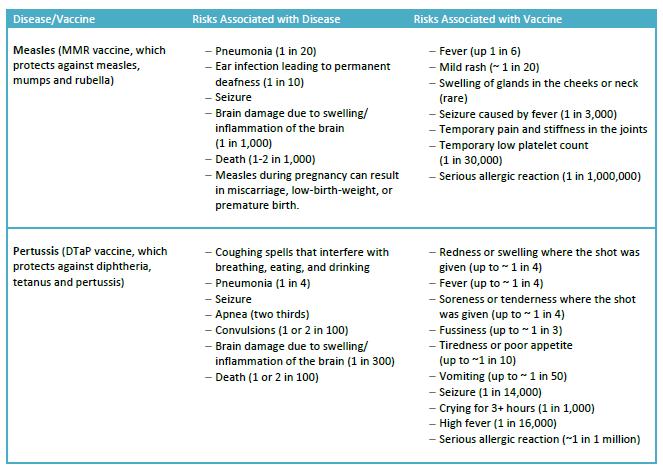Tenderness and swelling? Good! These mild side effects tell us that the immune system is working.
In the seventh installment of the Immunology 101 Series, Aimee will explain the science behind the side effects of immunization.
Have you ever noticed that soon after you or your child receive an immunization the injection site may appear to be red and slightly swollen? These mild side effects are extremely common and occur not only after injections, but also after cuts or scratches on our skin. Although the injection site may be tender for a day or two, it is important to understand that these side effects are signs that the immune system is working. Redness and swelling tell us that our immune cells are responding to the pathogenic components in the vaccine and have begun training to provide long-lasting protection.
Systems are in place to continually monitor vaccine safety and efficacy
Before we dive into the details of the potential risks of vaccination, it is important to remember that there are systems in place that continually monitor vaccines to protect children from rare side effects. The Vaccine Adverse Event System (VAERS) and the Vaccine Safety Data Link (VSD) were created to make sure that extremely high standards for vaccine safety are always upheld.
Keep in mind that because vaccines are given to otherwise healthy individuals, vaccine safety trials are quite rigorous and the standards for safety are extremely high.
What are the most common side effects of vaccination?
The most common side effects from vaccination include swelling and tenderness at the injection site or a low-grade fever. From an immunologist’s perspective, mild side effects at the injection site are welcome signs that the immune system is doing its job. Tenderness and swelling are the result of immune cells being recruited to the injection site. A low-grade fever or heat surrounding the injection site is a result of activated immune cells releasing molecules that produce fever and aid in the immune response. While it can be tough to see your child experience pain, soreness or fever, all of these mild side effects let us know that the immune system is responding to the vaccine and that the immune cells have begun their training against the pathogen. Long-lasting protection is only about a week away!
Are there any rare side effects that can occur after vaccination?
The risk of a vaccine causing a serious reaction is extremely rare, but like any other medicine or therapeutic, serious allergic reaction is possible. As mentioned above, most vaccine side effects are minor and go away within a few days. In rare instances, a vaccine could cause a more moderate reaction, such as a short-lived fever of 105 degrees or higher, fever-associated seizures, and inconsolable crying. While it is very rare, vaccines can cause serious reactions (see below). Due to the creation of the Vaccine Adverse Event System (VAERS) and the Vaccine Safety Data Link (VSD), any rare events reported on these monitoring systems are reviewed immediately and further action is taken if needed.
To vaccinate or not to vaccinate? A quick comparison of the risks
Let’s take a look at two highly contagious and deadly diseases that are experiencing resurgences in the United States due to decreased vaccination rates – measles and pertussis, also known as ‘whooping cough’.
Prior to the measles vaccine approximately 4 million children were infected per year and 500 children died. Although measles was nearly eliminated in the United States, in recent years outbreaks of measles have occurred in several cities. Measles is still a serious health concern in most developing countries and is one of the leading causes of death worldwide. Because the measles vaccine has no serious permanent side effects, its benefits still clearly outweigh its risks.
Prior to the vaccine for pertussis about 8,000 children died per year compared to about 10 deaths per year from pertussis after the vaccine was made available. Pertussis is very common in the United States. Although the uncontrollable cough and related health issues can be very serious in adolescents and adults, most of the deaths from pertussis occur in young infants. The benefits of the pertussis vaccine clearly outweigh its risks.
The benefits of vaccination far outweigh the risks
A well-informed community with scientifically accurate vaccine information from reputable and trusted sources (e.g.. the CDC, your child’s pediatrician) will recognize what the medical community has acknowledged for years – the benefits of vaccination far outweigh the risks.
SOURCES:
1. CDC website – MMR Vaccine Information Statement
http://www.cdc.gov/vaccines/pubs/vis/downloads/vis-mmr.pdf</a.
2. CDC website – ‘Measles Overview’
http://www.cdc.gov/measles/about/overview.html
3. CDC website – ‘Complications of Measles’
http://www.cdc.gov/measles/about/complications.html
4. CDC website – DTaP Vaccine Information Statement
http://www.cdc.gov/vaccines/pubs/vis/downloads/vis-dtap.pdf
5. CDC website – ‘Possible Side-effects from Vaccines’
http://www.cdc.gov/vaccines/vac-gen/side-effects.htm#mmr
6. CDC website – ‘Complications of Pertussis’
http://www.cdc.gov/pertussis/about/complications.html
7. World Health Organization (WHO) website – ‘Tetanus and neonatal tetanus’ http://www.wpro.who.int/immunization/factsheets/tetanus_nt/en/index.html
8. CDC website – ‘Vaccine Safety’ and ‘Addressing Common Concerns’
http://www.cdc.gov/vaccinesafety/Concerns/Index.html
9. The Children’s Hospital of Philadelphia Vaccine Education Center
<http://www.chop.edu/service/vaccine-education-center/


